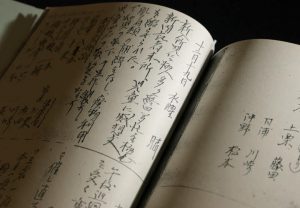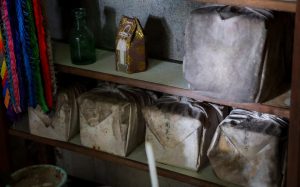Documenting Hiroshima of 1945: In December, repatriated orphans cared for in Ujina
Dec. 15, 2024
“Many newly admitted children are sick, making us extremely busy throughout the day”
by Minami Yamashita, Staff Writer
In December 1945, a home for repatriated orphans stood at a corner of barracks for the former Japanese Imperial Army Shipping Command in the area of Ujina (in Hiroshima City’s present-day Minami Ward). The facility was established by Yorito Kamikuri, 26 at the time, who had just been demobilized from the Army, using his own money. The home served to provide protection to orphans who had been repatriated from locations overseas, such as the Philippines, but had not been claimed by anyone.
Mr. Kamikuri and care workers took care of the children. The home’s “Childcare journal” for December described scenes of the orphaned children being accepted at the facility, indicating how, “Thirty-one repatriated children were admitted into the home from Otake,” in an entry dated December 17. An entry on December 19 explains that, “Many newly admitted children are sick, making us extremely busy throughout the day.” On December 25, the journal described how tangerine oranges had been bought in celebration of Christmas, adding that, “After dinner, we held a joyous gathering around the stove and gave each child two tangerines.”
In contrast, the journal also contains an entry dated December 13 that reads, “Masako Nakasone died (from malnutrition).” A physician would visit the home twice a month. “A few children are very sick. We hope the doctor can examine them quickly,” read an entry dated December 23. The Hiroshima Red Cross Hospital also cooperated in providing treatment for the children but, according to Hiroshima Prefectural History, published in 1983, “Day after day, sick children would be sent to the Red Cross Hospital, with the dead brought back to the home and funerals held.”
Lingering regrets from relief work
On August 6, 1945, Mr. Kamikuri, on vacation from his work, experienced the atomic bombing at his home in the outskirts of Hiroshima City. Later, he headed to the central area of the city via the Yokogawa district to help with relief work. At that time, he witnessed a baby suckling at the breast of its dead mother. His regret of giving the baby water from his canteen and leaving the scene remained with him. Mr. Kamikuri’s oldest son, Tetsuo, 75, a resident of Higashihiroshima City, said, “My father apparently then made the decision to devote his life to orphans.”
Mr. Kamikuri began to help support orphans by bringing supplies to an orphanage that had been established in Hijiyama National School (present-day Hijiyama Elementary School, in Hiroshima’s Minami Ward). In October, repatriation ships beginning to arrive at ports in Hiroshima Prefecture carried orphans suffering from malnutrition and illness. And on October 22, Mr. Kamikuri opened the home to provide protection for the children.
For young children unable to say their own names, he gave them new ones, such as “Ichiko Minami” or “Chiyoko Minami,” because they had been repatriated from locations to the south (“minami,” in Japanese) of Japan. By December, the facility had taken in 220 children, of whom 40 reportedly died.
Led to founding of Shinsei Gakuen
In 1946, the facility was relocated to the area of Kusatsuhigashi-machi (in Hiroshima’s present-day Nishi Ward), where it continued accepting war orphans. Starting in 1947, the home started operations in the area of Motomachi (in the city’s Naka Ward). In 1971, it settled into its current location in Higashihiroshima City, later being turned into the Hiroshima Shinsei Gakuen orphanage. Mr. Kamikuri wrote in to the evening edition of the Chugoku Shimbun published on August 4, 1988, that, “For the first three or four years after opening the facility, I was completely absorbed in my work.”
Established on the grounds of the school is an ossuary, which houses urns holding the remains of 10 repatriated orphans. A memorial monument for the A-bomb victims, displaying a motif of the mother and child Mr. Kamikuri was unable to save that day, is engraved with a poem in Mr. Kamikuri’s handwriting. “Suffering burns and melting in the inferno, if only they had been alive, I could have at least given them water; so many souls, our brethren, rose to heaven together in sorrow, on that day of flames, so many deep regrets.”
(Originally published on December 15, 2024)









